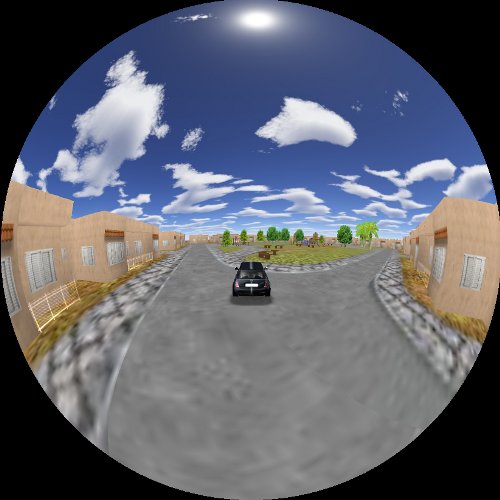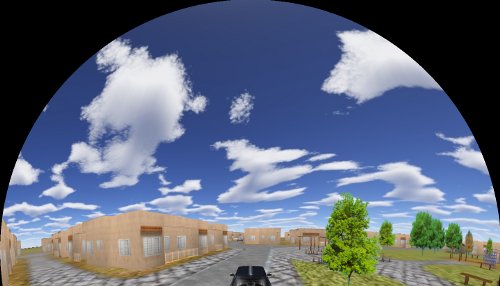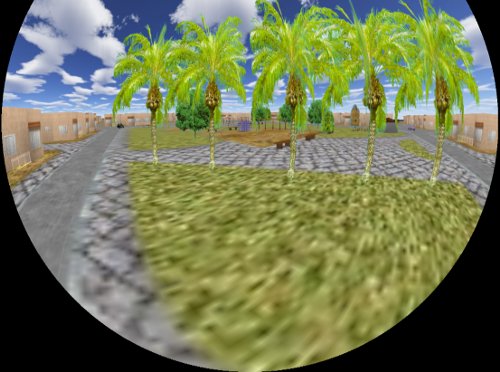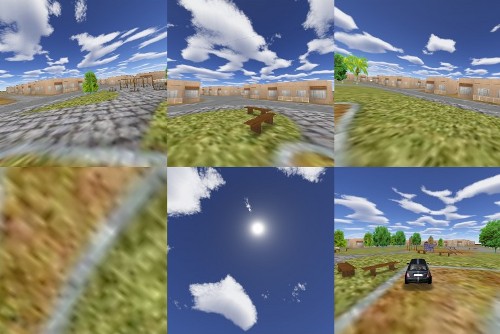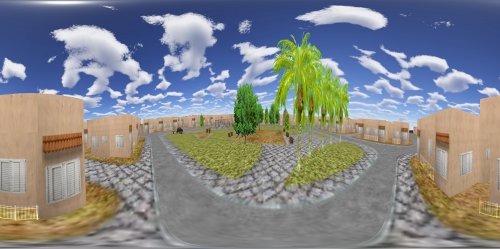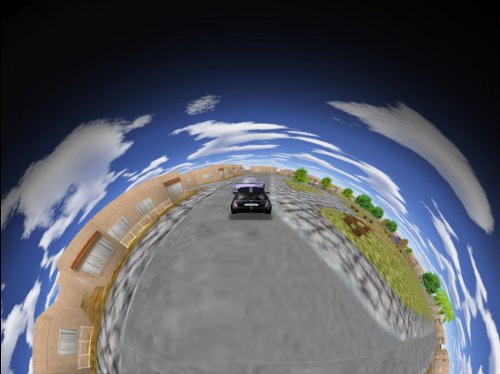Doc:2.6/Manual/Game Engine/Camera/Dome mode
Dome Mode in Blender Game Engine
This feature allows artists to visualize their interactive projects within an immersive dome environment. In order to make it an extensible tool, we are supporting Fulldome, Truncated domes (front and rear), Planetariums and domes with spherical mirrors.
The support has been added to Blender 2.49. It uses a multipass texture algorithm as developed by Paul Bourke and was implemented by Dalai Felinto with sponsorship from SAT - Society for Arts and Technology within the SAT Metalab immersion research program.[1]Briefly, that involves rendering the scene 4 times and placing the subsequent images onto a mesh designed especially such that the result, when viewed with an orthographic camera, is a fisheye projection.
Note
Remember to use Blender in fullscreen mode to get the maximum out of your projector. To accomplish that launch Blender with the command-line argument -W. Also to get away of the top menu on Blender try to join all windows (buttons, 3dview, text, ...) in a single one. Otherwise if you only maximize it (Ctrl+Up) you can't get the whole screen free to run your game (the top bar menu takes about 20 pixels). |
Dome Camera Settings
- Dome Type
- This menu allow you to select which type of dome camera to use. They are outlined below, along with the settings that appear below.
Available camera settings change depending on the selected Dome Type:
- Resolution
- Sets the resolution of the Buffer. Decreasing this value increases speed, but decreases quality
- Tesselation
- 4 is the default. This is the tesselation level of the mesh. (Not available in Cube Map mode).
- Angle
- Sets the field of view of the dome in degrees, from 90 to 250. (Available in Fisheye and Truncated modes).
- Tilt
- Set the camera rotation in the horizontal axis. Available in Fisheye and Truncated modes).
- Warp Data
- Use a custom warp mesh data file.
Fisheye Mode
An Orthogonal Fisheye view from 90º to 250º degrees.
- From 90º to 180º we are using 4 renders.
- From 181º to 250º we are using 5 renders.
Front-Truncated Dome Mode
Designed for truncated domes, this mode aligns the fisheye image with the top of the window while touching the sides.
- The Field of view goes from 90º to 250º degrees.
- From 90º to 180º we are using 4 renders.
- From 181º to 250º we are using 5 renders.
Rear-Truncated Dome Mode
Designed for truncated domes, this mode aligns the fisheye image with the bottom of the window while touching the sides.
- The Field of view goes from 90º to 250º degrees.
- From 90º to 180º we are using 4 renders.
- From 181º to 250º we are using 5 renders.
Cube Map Mode
Cube Map mode can be used for pre-generate animated images for CubeMaps.
- We are using 6 renders for that. The order of the images follows Blender internal EnvMap file format:
- first line: right, back, left
- second line: bottom, top, front
Spherical Panoramic
A full spherical panoramic mode.
- We are using 6 cameras here.
- The bottom and top start to get precision with Definition set to 5 or more.
Warp Data Mesh
Many projection environments require images that are not simple perspective projections that are the norm for flat screen displays. Examples include geometry correction for cylindrical displays and some new methods of projecting into planetarium domes or upright domes intended for VR.
For more information on the mesh format see Paul Bourke's article.
In order to produce that images, we are using a specific file format.
File template::
mode width height n0_x n0_y n0_u n0_v n0_i n1_x n1_y n1_u n1_v n1_i n2_x n1_y n2_u n2_v n2_i n3_x n3_y n3_u n3_v n3_i (...)
First line is the image type the mesh is support to be applied to: 2 = rectangular, 1 = radialNext line has the mesh dimensions in pixelsRest of the lines are the nodes of the mesh.
Each line is compund of x y u v i(x,y) are the normalised screen coordinates(u,v) texture coordinatesi a multiplicative intensity factor
x varies from -screen aspect to screen aspecty varies from -1 to 1u and v vary from 0 to 1i ranges from 0 to 1, if negative don't draw that mesh node
- You need to create the file and add it to the Text Editor in order to select it as your Warp Mesh data file.
- Open the Text Editor (Window Types/Text Editor).
- Open your mesh data file(ie. myDome.data) in the text editor (Text/Open or Alt O on keyboard).
- Go to Game Framing Settings (Window Types/Buttons Window/Scene Page or F10 on keyboard)
- Enable Dome Mode.
- Type filename in Warp Data field(ie. myDome.data).
To create your own Warp Meshes an interactive tool called meshmapper is available as part of Paul Bourke's Warpplayer software package(requires full version).
Example files
Spherical Mirror Dome 4x3, Truncated Dome 4x3, Sample Fullscreen File 4x3, Sample Fullbuffer File 4x3.
Note
Important: the viewport is calculated using the ratio of canvas width by canvas height. Therefore different screen sizes will require different warp mesh files. Also in order to get the correct ratio of your projector you need to use Blender in Fullscreen mode.
|
